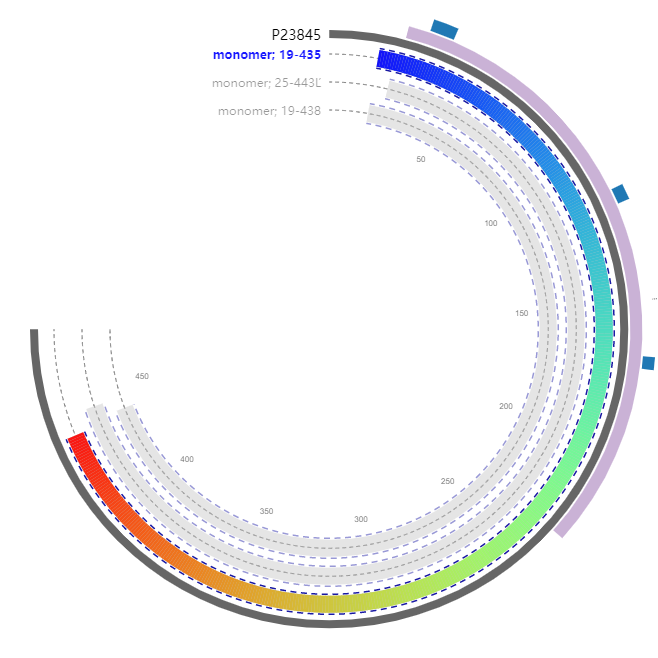Catalyzes the synthesis of activated sulfate. This protein is involved in the subpathway that synthesizes sulfite from sulfate. ATP + H+ + sulfate = adenosine 5'-phosphosulfate + diphosphate
MNTALAQQIANEGGVEAWMIAQQHKSLLRFLTCGSVDDGKSTLIGRLLHDTRQIYEDQLS
SLHNDSKRHGTQGEKLDLALLVDGLQAEREQGITIDVAYRYFSTEKRKFIIADTPGHEQY
TRNMATGASTCELAILLIDARKGVLDQTRRHSFISTLLGIKHLVVAINKMDLVDYSEETF
TRIREDYLTFAGQLPGNLDIRFVPLSALEGDNVASQSESMPWYSGPTLLEVLETVEIQRV
VDAQPMRFPVQYVNRPNLDFRGYAGTLASGRVEVGQRVKVLPSGVESNVARIVTFDGDRE
EAFAGEAITLVLTDEIDISRGDLLLAADEALPAVQSASVDVVWMAEQPLSPGQSYDIKIA
GKKTRARVDGIRYQVDINNLTQREVENLPLNGIGLVDLTFDEPLVLDRYQQNPVTGGLIF
IDRLSNVTVGAGMVHEPVSQATAAPSEFSAFELELNALVRRHFPHWGARDLLGDK
483

| PMID | Title & Author | Abstract | Year | |
| 0 | 25807013 | Crystal structures of the kinase domain of the sulfate-activating complex in Mycobacterium tuberculosis.Ömer Poyraz , Katharina Brunner , Bernhard Lohkamp , Hanna Axelsson , Lars G J Hammarström , Robert Schnell , Gunter Schneider | In Mycobacterium tuberculosis the sulfate activating complex provides a key branching point in sulfate assimilation. The complex consists of two polypeptide chains, CysD and CysN. CysD is an ATP sulfurylase that, with the energy provided by the GTPase activity of CysN, forms adenosine-5'-phosphosulfate (APS) which can then enter the reductive branch of sulfate assimilation leading to the biosynthesis of cysteine. The CysN polypeptide chain also contains an APS kinase domain (CysC) that phosphorylates APS leading to 3'-phosphoadenosine-5'-phosphosulfate, the sulfate donor in the synthesis of sulfolipids. We have determined the crystal structures of CysC from M. tuberculosis as a binary complex with ADP, and as ternary complexes with ADP and APS and the ATP mimic AMP-PNP and APS, respectively, to resolutions of 1.5 Å, 2.1 Å and 1.7 Å, respectively. CysC shows the typical APS kinase fold, and the structures provide comprehensive views of the catalytic machinery, conserved in this enzyme family. Comparison to the structure of the human homolog show highly conserved APS and ATP binding sites, questioning the feasibility of the design of specific inhibitors of mycobacterial CysC. Residue Cys556 is part of the flexible lid region that closes off the active site upon substrate binding. Mutational analysis revealed this residue as one of the determinants controlling lid closure and hence binding of the nucleotide substrate. | 2015 |
| 1 | 2828368 | The sulfate activation locus of Escherichia coli K12: cloning, genetic, and enzymatic characterization.T S Leyh , J C Taylor, G D Markham | The sulfate activation locus of Escherichia coli K12 has been cloned by complementation. The genes and gene products of this locus have been characterized by correlating the enzyme activity, complementation patterns, and polypeptides associated with subclones of the cloned DNA. The enzymes of the sulfate activation pathway, ATP sulfurylase (ATP:sulfate adenylyltransferase, EC 2.7.7.4) and APS kinase (ATP:adenosine-5'-phosphosulfate 3'-phosphotransferase, EC 2.7.1.25) have been overproduced approximately 100-fold. Overproduction of ATP sulfurylase requires the expression of both the cysD gene, encoding a 27-kDa polypeptide, and a previously unidentified gene, denoted cysN, which encodes a 62-kDa polypeptide. Purification of ATP sulfurylase to homogeneity reveals that the enzyme is composed of two types of subunits which are encoded by cysD and cysN. Insertion of a kanamycin resistance gene into plasmid or chromosomal cysN prevents sulfate activation and decreases expression of the downstream cysC gene. cysC appears to be the APS kinase structural gene and encodes a 21-kDa polypeptide. The genes are adjacent and are transcribed counterclockwise on the E. coli chromosome in the order cysDNC. cysN and cysC are within the same operon and cysDNC are not in an operon containing cysHIJ. | 1988 |
| 2 | 9611812 | Regulation of the sulfate starvation response in Pseudomonas aeruginosa: role of cysteine biosynthetic intermediates.J Hummerjohann , E Küttel, M Quadroni, J Ragaller, T Leisinger, M A Kertesz | Pseudomonas aeruginosa PAO1 grew in defined synthetic medium with any of a broad variety of single sulfur sources, including sulfate, cysteine, thiocyanate, alkanesulfonates, organosulfate esters and methionine, but not with aromatic sulfonates, thiophenols or organothiocyanates or isothiocyanates. During growth with any of these compounds except sulfate, cysteine or thiocyanate, a set of 10 sulfate starvation-induced (SSI) proteins was strongly up-regulated, as observed by two-dimensional protein electrophoresis of total cell extracts. A comparable level of up-regulation was found for the hydrolytic enzyme arylsulfatase, which has previously been used as a marker enzyme for the sulfate starvation response. One of the SSI proteins was identified by N-terminal sequencing as a high-affinity periplasmic sulfate-binding protein, and another was related to thiol-specific antioxidants, but the N-terminal sequences of the other SSI proteins revealed no similarity to N-termini of proteins of known function, and they probably represent uncharacterized enzymes involved in sulfur scavenging when preferred sulfur sources are absent. To study the role that cysteine biosynthetic intermediates play in the synthesis of these proteins in vivo, we isolated mini-Tn5 transposon mutants of P. aeruginosa with insertions in the cysN and cysI genes, which encode subunits of ATP-sulfurylase and sulfite reductase, respectively. These two genes were cloned and sequenced. cysI showed high similarity to the cognate gene in Escherichia coli, whereas cysN encoded a 69.3 kDa protein with two domains corresponding to the E. coli CysN and CysC proteins. Sulfate no longer repressed synthesis of the SSI proteins in cysN mutants, but repression was restored by sulfite; in the cysI mutant, sulfate, sulfite and sulfide all led to repression of SSI protein synthesis. This suggests that there are at least two independent corepressors of the sulfate starvation response in this species. | 1998 |
This protein is involved in step 1 of the subpathway that synthesizes sulfite from sulfate.